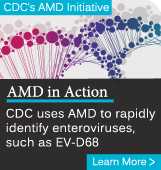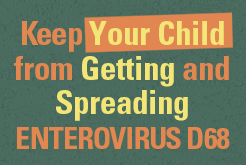Enterovirus D68
Español: Enterovirus D68
What is enterovirus D68?
Enterovirus D68 (EV-D68) is one of more than 100 non-polio enteroviruses. This virus was first identified in California in 1962.
How common is EV-D68 in the United States?
Small numbers of EV-D68 have been reported regularly to CDC since 1987. However, during 2014 the number of people reported with confirmed EV-D68 infection was much greater than that reported in previous years. We can’t predict whether EV-D68 will be a common type of enterovirus detected this year or in future seasons. That’s because a mix of enteroviruses circulates every year, and different types of enteroviruses can be common in different years.
What time of the year are people most likely to get infected?
In the United States, you are more likely to get infected with enteroviruses in the summer and fall. However, you can get infected year round.
What is happening with EV-D68 in 2016?
Updated July 2016
CDC is aware of limited sporadic EV-D68 detections in the U.S. in 2016. There is no indication of unusual activity. Enteroviruses are ever-present in the community, and each year we expect to detect cases. As in previous years, CDC will continue to work in 2016 with states by testing specimens to determine virus type, supporting the identification and investigation of outbreaks, and monitoring seasonal activity.
What happened with EV-D68 in 2015?
U.S. laboratories reported zero EV-D68 detections to CDC's National Enterovirus Surveillance System (NESS) during the 2015 enterovirus season (summer and fall). Also, CDC received about 700 specimens for enterovirus testing during 2015; zero were positive for EV-D68, many were positive for a rhinovirus type.
What happened with EV-D68 in 2014?
In summer and fall 2014, the United States experienced a nationwide outbreak of EV-D68 associated with severe respiratory illness. From mid-August 2014 to January 15, 2015, CDC or state public health laboratories confirmed a total of 1,153 people in 49 states and the District of Columbia with respiratory illness caused by EV-D68. Almost all of the confirmed cases were among children, many whom had asthma or a history of wheezing. Additionally, there were likely many thousands of mild EV-D68 infections for which people did not seek medical treatment and/or get tested.
CDC received about 2,600 specimens for enterovirus testing during 2014, which was substantially more than usual. About 36% of those tested positive for EV-D68. About 33% tested positive for an enterovirus or rhinovirus other than EV-D68.
EV-D68 was detected in specimens from 14 patients who died in the U.S. in 2014. State and local officials have the authority to determine and release information about the cause of these deaths.
What are the symptoms of EV-D68 infection?
EV-D68 can cause mild to severe respiratory illness, or no symptoms at all.
- Mild symptoms may include runny nose, sneezing, cough, body aches, and muscle aches.
- Severe symptoms may include wheezing and difficulty breathing.
Anyone with respiratory illness should contact their doctor if they are having difficulty breathing or if their symptoms are getting worse.
How does the virus spread?
Since EV-D68 causes respiratory illness, the virus can be found in an infected person’s respiratory secretions, such as saliva, nasal mucus, or sputum. EV-D68 likely spreads from person to person when an infected person coughs, sneezes, or touches a surface that is then touched by others.
Who is at risk?
In general, infants, children, and teenagers are most likely to get infected with enteroviruses and become ill. That's because they do not yet have immunity (protection) from previous exposures to these viruses. We believe this is also true for EV-D68. Adults can get infected with enteroviruses, but they are more likely to have no symptoms or mild symptoms.
Children with asthma may have a higher risk for severe respiratory illness caused by EV-D68 infection.
Watch CDC medical epidemiologist Brian Rha explain who is at risk for EV-D68 and more in a 2-minute video on WebMD.
How is it diagnosed?
EV-D68 can only be diagnosed by doing specific lab tests on specimens from a person’s nose and throat, or blood. Many hospitals and some doctor’s offices can test ill patients to see if they have enterovirus infection. However, most cannot do specific testing to determine the type of enterovirus, like EV-D68. CDC and some state health departments can do this sort of testing using a real-time reverse transcription polymerase chain reaction (rRT-PCR) lab test, which allows testing and reporting of results within a few days of receiving specimens. Health departments may contact CDC for further enterovirus typing.
CDC recommends that clinicians only consider EV-D68 testing for patients with severe respiratory illness and when the cause is unclear or unusual. For more information, see Enterovirus D68 for Health Care Professionals.
What are the treatments?
There is no specific treatment for people with respiratory illness caused by EV-D68. Talk to a doctor about your symptoms and the best way to control them.
Some people with severe respiratory illness may need to be hospitalized and receive intensive supportive therapy.
There are no antiviral medications currently available for people who become infected with EV-D68.
How can I protect myself?
You can help prevent yourself from getting and spreading EV-D68 by following these steps:
- Wash your hands often with soap and water for 20 seconds. See Handwashing: Clean Hands Save Lives.
- Avoid touching your eyes, nose and mouth with unwashed hands.
- Avoid close contact such as kissing, hugging, and sharing cups or eating utensils with people who are sick, and when you are sick.
- Cover your coughs and sneezes with a tissue or shirt sleeve, not your hands.
- Clean and disinfect frequently touched surfaces, such as toys and doorknobs, especially if someone is sick.
- Stay home when you are sick.
Also, see an infographic that shows these prevention steps.
There are no vaccines for preventing EV-D68 infections.
What should people with asthma and children suffering from reactive airway disease do?
Children with asthma may have a higher risk for severe symptoms from EV-D68 and other respiratory illnesses. They should follow CDC's guidance to maintain control of their illness during enterovirus season, which occurs each year in the U.S. during summer and fall.
CDC recommends the following:
- Discuss and update your asthma action plan with your primary care provider.
- Take your prescribed asthma medications as directed, especially long-term control medication(s).
- Be sure to keep your reliever medication with you.
- Get a flu vaccine when available each year.
- If you develop new or worsening asthma symptoms, follow the steps of your asthma action plan. If your symptoms do not go away, call your doctor right away.
- Parents should make sure the child’s caregiver and/or teacher is aware of his/her condition, and that they know how to help if the child experiences any symptoms related to asthma.
For additional information, see “What Parents Need to Know about Enterovirus D68” in
- English
- Spanish
- Haitian Creole (translation provided by State of New Jersey Department of Health)
Watch CDC medical epidemiologist Brian Rha explain who is at risk for EV-D68 and more in a 2-minute video on WebMD.
- Page last reviewed: June 10, 2016
- Page last updated: July 19, 2016
- Content source:



 ShareCompartir
ShareCompartir

